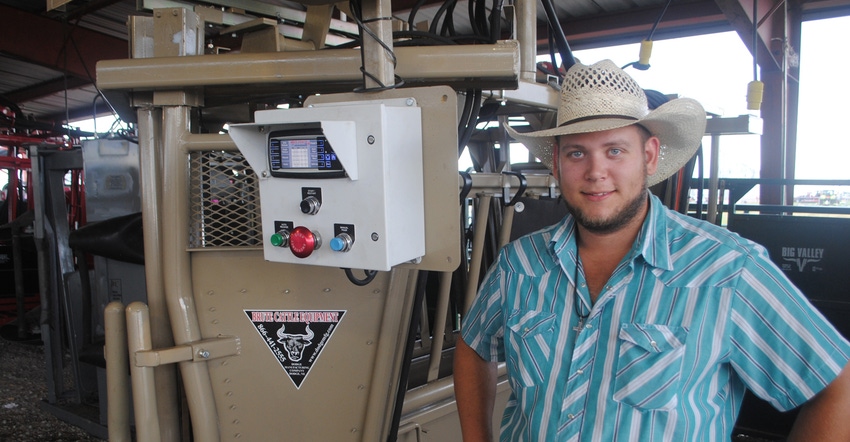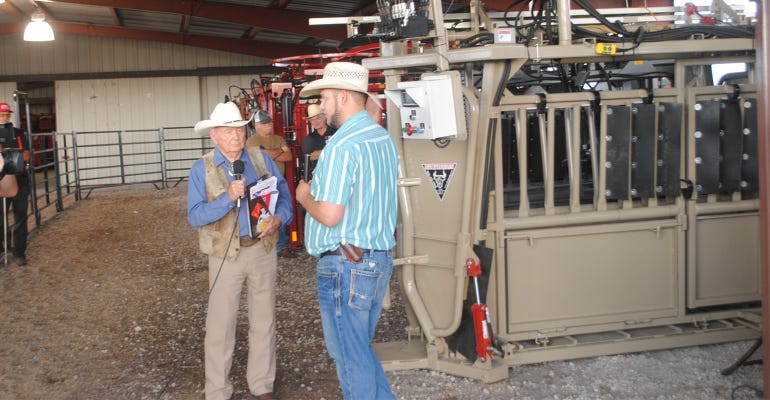Brute Cattle Co. developed a chute that improves time efficiency and saves on labor.

Whether you run a million head of cattle through the chute every year, or several hundred, having enough help on hand for processing is crucial.
Brute Cattle Co., Dodge, Neb., commercially unveiled its new Brute Stealth Autonomous Catch-chute Elite more than a year ago, after significant research, development and testing of the technology dating back to the first patent on the chute filed in 2014.
This automated ACE uses sensors to recognize when an animal enters the chute, closing the headgate and employing the squeeze automatically, while the producer administers vaccinations and implants and processes the animals.
According to Austin Gubbels, Brute sales representative, the autonomous package allows for less labor needs during processing and offers a hands-free way to work cattle.
Although Husker Harvest Days did not take place in person this fall, live cattle-handling demonstrations were filmed on-site at the showgrounds for the Farm Progress Virtual Experience that began online Sept. 15-17, and the Brute Stealth ACE was on hand.
Gubbels, who operated the chute for the demonstrations, says the combination of sensors and a software package essentially "think" the same way as a human chute operator. "Sometimes a calf will balk at entering the chute, so the computer knows that," Gubbels says. "It will release the squeeze portion and headgate a bit until the calf gets into the chute, so the animal can be caught and processed."
The autonomous ACE package can be fitted on any Brute Stealth chute, Gubbels explains. To run the chute, the operator simply presses a start button to initiate the computers and sensors before processing begins.

DEMONSTRATION TIME: "Dr. Joe" Jeffrey (left) interviews Austin Gubbels during the filming of live cattle-handling demonstrations at HHD. The Brute Stealth ACE chute was one of six chutes demonstrated during the live event. Gubbels notes that the software and sensors of the chute "think" like a human operator and are able to respond, even when calves balk at going into the chute.

There are four presettings according to the size and weight of the animals being worked, ranging from calves all the way up to mature cows and bulls. These presettings help set parameters for the headgate and squeeze parts of the chute, but they can be changed with the press of a button if producers are working a mixed group.
The chute automatically sets up for receiving an animal and catches the animal automatically. Once processing is completed, the operator can push a button on the main panel, or press a button on a remote, to release the animal.
"Once the animal is released from the chute, the software waits for the animal to clear and then resets for the next animal to enter the chute," Gubbels says.
Development of this unique chute didn't come overnight. "We completed our first prototype back in 2017," Gubbels says. "We have our own feedyard, so we were testing the chute one day," he explains. "We had a group of calves that were being difficult and running circles in the tub, so I left the chute and helped move the calves up. All of a sudden, we heard the motors on the chute operating from about 10 feet away. We walked up to the chute, and it had one of the calves caught."
As part of the ACE package, producers can buy different features that include the autonomous package and remote control, as well as a weighing feature and a pour-on application feature. "These packages allow not only for hands-free chute operation, but the chute can weigh the animal and automatically pour the cattle, according to the animal's weight," Gubbels says.
Time efficiency comes into play with the autonomous package. "Not only does it save a few seconds and additional labor because of the autonomous operation, but the weight and pour-on features save pour-on dewormer because the exact dose needed is applied to every animal," Gubbels says. "It takes out the human error."

PANEL SETTINGS: As part of the startup of the system before processing, the ACE chutes have four presettings that allow for parameters on the headgate and squeeze to cover animals ranging from calves all the way up to mature cows and bulls. Main controls to release each animal after processing also can be done from remote control.

The ACE package includes two Brute Cattle Co. patents — the autonomous part of the chute, as well as the angled headgate that works perfectly with the angled shape of a beef animal's shoulders.
Gubbels notes that there is always a human safety concern with hydraulic chutes. That's why Brute developers installed safety sensors in key areas of the chute to sense and shut the whole system down to prevent a worker from being caught or injured.
Other sensors that play the key roles in the autonomous package are all located at the top of the chute, outside the splash zone for manure and above the portions of the chute where the animal can contact the sensors.
Gubbels is confident not only in the unique operation of the ACE, but also in its longevity. "Our chutes are made heavy, so longevity is not a concern, and we've had the ACE chutes out in feedyards for more than a year," he says. "Some of these yards have run more than a million head through the chutes with no problems."
While large feedyards could be the main consumer for the ACE, Gubbels says that the chutes also may work for smaller operators who find it difficult to locate extra labor during processing.
Learn more about the Brute ACE package for Stealth chutes by going online at dodgemfg.com. To see the ACE and the other chutes in action at the HHD site, visit FPVX at huskerharvestdays.com or farmprogressshow.com.
About the Author(s)
You May Also Like





